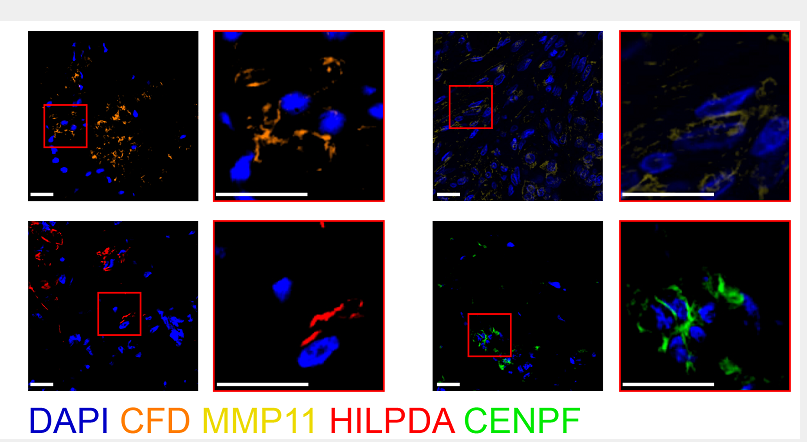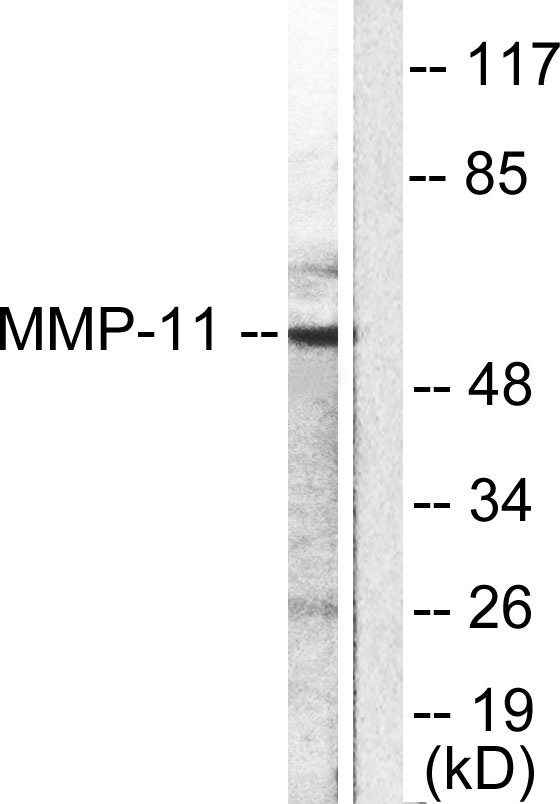MMP-11 Polyclonal Antibody
- Catalog No.:YT2794
- Applications:WB;IHC;IF;ELISA
- Reactivity:Human;Mouse;Rat
- Target:
- MMP-11
- Gene Name:
- MMP11
- Protein Name:
- Stromelysin-3
- Human Gene Id:
- 4320
- Human Swiss Prot No:
- P24347
- Mouse Gene Id:
- 17385
- Mouse Swiss Prot No:
- Q02853
- Rat Gene Id:
- 25481
- Rat Swiss Prot No:
- Q499S5
- Immunogen:
- The antiserum was produced against synthesized peptide derived from human MMP-11. AA range:61-110
- Specificity:
- MMP-11 Polyclonal Antibody detects endogenous levels of MMP-11 protein.
- Formulation:
- Liquid in PBS containing 50% glycerol, 0.5% BSA and 0.02% sodium azide.
- Source:
- Polyclonal, Rabbit,IgG
- Dilution:
- WB 1:500 - 1:2000. IHC 1:100 - 1:300. IF 1:200 - 1:1000. ELISA: 1:20000. Not yet tested in other applications.
- Purification:
- The antibody was affinity-purified from rabbit antiserum by affinity-chromatography using epitope-specific immunogen.
- Concentration:
- 1 mg/ml
- Storage Stability:
- -15°C to -25°C/1 year(Do not lower than -25°C)
- Other Name:
- MMP11;STMY3;Stromelysin-3;SL-3;ST3;Matrix metalloproteinase-11;MMP-11
- Observed Band(KD):
- 60kD
- Background:
- Proteins of the matrix metalloproteinase (MMP) family are involved in the breakdown of extracellular matrix in normal physiological processes, such as embryonic development, reproduction, and tissue remodeling, as well as in disease processes, such as arthritis and metastasis. Most MMP's are secreted as inactive proproteins which are activated when cleaved by extracellular proteinases. However, the enzyme encoded by this gene is activated intracellularly by furin within the constitutive secretory pathway. Also in contrast to other MMP's, this enzyme cleaves alpha 1-proteinase inhibitor but weakly degrades structural proteins of the extracellular matrix. [provided by RefSeq, Jul 2008],
- Function:
- cofactor:Binds 1 calcium ion per subunit.,cofactor:Binds 2 zinc ions per subunit.,domain:The conserved cysteine present in the cysteine-switch motif binds the catalytic zinc ion, thus inhibiting the enzyme. The dissociation of the cysteine from the zinc ion upon the activation-peptide release activates the enzyme.,function:May play an important role in the progression of epithelial malignancies.,PTM:The precursor is cleaved by a furin endopeptidase.,similarity:Belongs to the peptidase M10A family.,similarity:Contains 4 hemopexin-like domains.,tissue specificity:Specifically expressed in stromal cells of breast carcinomas.,
- Subcellular Location:
- Secreted, extracellular space, extracellular matrix .
- Expression:
- Specifically expressed in stromal cells of breast carcinomas.
Pan-cancer spatially resolved single-cell analysis reveals the crosstalk between cancer-associated fibroblasts and tumor microenvironment. Molecular Cancer Qiang Feng IF Human 1:200 breast cancer (BRCA) tissue
- June 19-2018
- WESTERN IMMUNOBLOTTING PROTOCOL
- June 19-2018
- IMMUNOHISTOCHEMISTRY-PARAFFIN PROTOCOL
- June 19-2018
- IMMUNOFLUORESCENCE PROTOCOL
- September 08-2020
- FLOW-CYTOMEYRT-PROTOCOL
- May 20-2022
- Cell-Based ELISA│解您多样本WB检测之困扰
- July 13-2018
- CELL-BASED-ELISA-PROTOCOL-FOR-ACETYL-PROTEIN
- July 13-2018
- CELL-BASED-ELISA-PROTOCOL-FOR-PHOSPHO-PROTEIN
- July 13-2018
- Antibody-FAQs
- Products Images

- Pan-cancer spatially resolved single-cell analysis reveals the crosstalk between cancer-associated fibroblasts and tumor microenvironment. Molecular Cancer Qiang Feng IF Human breast cancer (BRCA) tissue,liver hepatocellular carcinoma (LIHC) tissue

- Western Blot analysis of various cells using MMP-11 Polyclonal Antibody diluted at 1:500

- Immunofluorescence analysis of A549 cells, using MMP-11 Antibody. The picture on the right is blocked with the synthesized peptide.

- Immunohistochemistry analysis of paraffin-embedded human breast carcinoma tissue, using MMP-11 Antibody. The picture on the right is blocked with the synthesized peptide.

- Western blot analysis of lysates from A549 cells, using MMP-11 Antibody. The lane on the right is blocked with the synthesized peptide.



